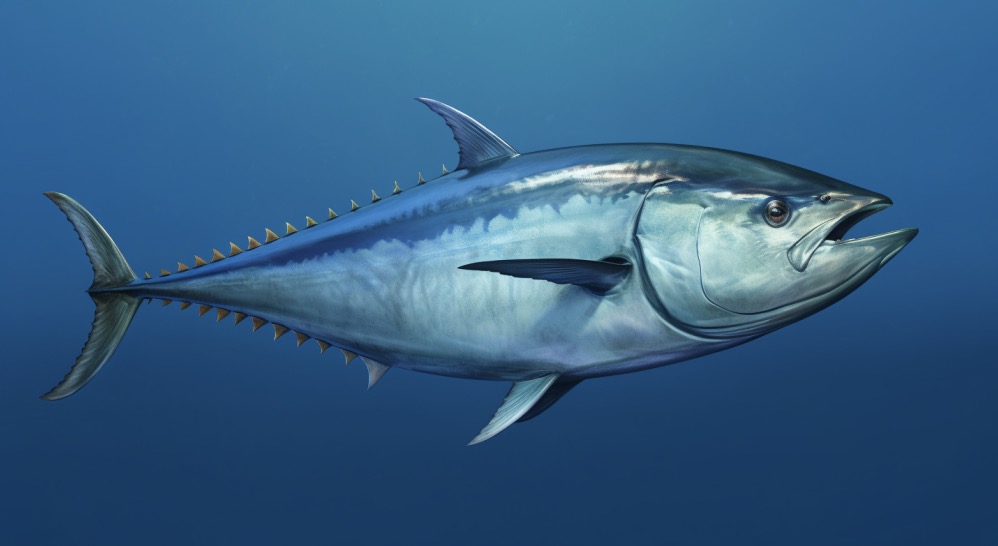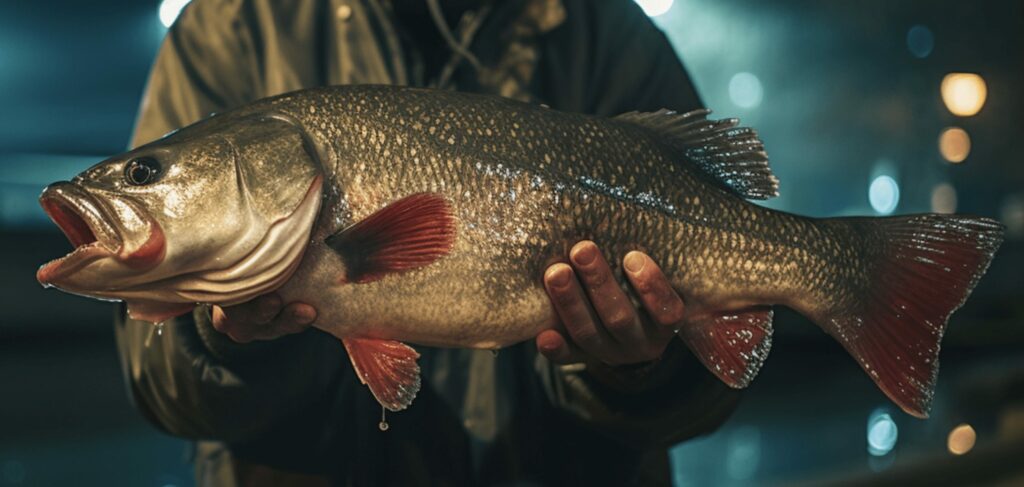When it comes to the thrilling pursuit of bluefin tuna, one of the most formidable opponents in the ocean, your choice of gear can make all the difference.
Among the most critical decisions you’ll make is selecting the right pound test for your fishing line.
This choice can mean the difference between a triumphant catch or a tale of the one that got away. So, let’s dive into the details and discover the ideal pound test line for reeling in a bluefin tuna.
What Pound Test Line for Bluefin Tuna?
If you’re gearing up to wrestle with bluefin tuna of the deep, one of the most critical factors to consider is the strength of your line, a.k.a. the ‘pound test‘.
Now, you might be thinking, “Just give me the strongest line available!” Well, not so fast.
You see, it’s about finding that balance, where the line is strong enough to hold the fish, but not so heavy that it interferes with the thrill of the fight.
So, what’s the magic number?
Generally, a 30-pound test line will serve you well. It’s a good balance between strength and subtlety, robust enough to keep a tight hold on the tuna while providing a fair bit of sport in the process.
“But what if I’m after the big boys?” I hear you ask.
Well, if you’re targeting Bluefin that tip the scales at up to 100 pounds, you might want to consider stepping up to a 40-pound test line. And with the heavier line, you’ll want a stouter rod and greater line capacity to handle the extra strain.
Remember, though, that even a 40-pound test line may not be enough if you come across a real sea monster. There are times when the giants show up, and even the heaviest setup can feel inadequate. But don’t let that discourage you. It’s all part of the adventure that is Bluefin tuna fishing.
Considerations When Selecting a Line for Bluefin Tuna

Material of the line
Here’s the deal with your fishing line choices, and trust me, it’s straightforward, no frills.
First up, we’ve got braided line. This stuff’s a favorite among the tuna-catchers – I mean, it’s strong, it’s thin, and it doesn’t stretch much, so you can feel Mr. Tuna’s every move. But it’s got a downside too – it’s about as subtle as a neon sign in clear water. Those sharp-eyed tunas might just turn tail at the sight of it.
Then we’ve got monofilament. Now, this line is like the good old reliable friend you can count on. It’s got some stretch to it – helps cushion the blow when a big bluefin decides to fight back. It’s also pretty easy to work with, ties nice and easy. But the trade-off? It’s a little on the thick side for its strength, so you might find your reel getting full quicker than you’d like.
Last up, we’ve got fluorocarbon. This stuff’s the ninja of fishing lines – nearly invisible underwater, which can really give you an edge with those eagle-eyed tunas. It’s also pretty tough, which is a bonus when you’re dealing with a fish that can chomp or thrash around. But, and there’s always a but, it’s pricey and a bit of a pain to knot.
So, what’s the verdict for bluefin tuna?
Well, it’s like putting together a dream team. You want the strength and capacity of the braided line on your reel, combined with a long fluorocarbon leader to fool those cunning tunas and handle their powerful moves.
Line visibility in water
Next up, let’s consider line visibility in water.
This is a biggie when you’re fishing for Bluefin Tuna as these guys have excellent eyesight, and if they can see your line, they’re likely to be spooked.
The color and material of your line can affect its visibility. So, clear or blue lines are generally less visible in the water, but remember, the material matters too.
Fluorocarbon, for instance, is less visible than braided lines, which is why it might be better for catching these types of fish.
Strength versus diameter
Now, let’s talk about strength versus diameter.
I’d say it’s a bit of a trade-off as a thicker line is going to be stronger, but it’s also going to be more visible in the water.
On the other hand, a thinner line is less visible and could be more appealing to Bluefin Tuna, but it might not be as strong or durable.
So, you’ve got to strike a balance between strength and visibility.
Knot strength
Knot strength is crucial to ensure the line holds under the strain of a fighting Bluefin Tuna.
For lines of 60lb test and below, a loop knot tied directly is recommended.
For lines above 60lb, crimping is preferred, with the use of ½” chafe gear to a 220lb swivel and attaching a similarly sized split ring to the swivel recommended to minimize torque during a battle
Types of Fishing Lines for Bluefin Tuna
When you’re gearing up for a Bluefin Tuna fishing adventure, the type of line you choose can be a game-changer.
And, in the world of Bluefin Tuna fishing, the three main dance partners are monofilament, fluorocarbon, and braid.
Each has its own unique, strengths, and weaknesses:
Monofilament
Monofilament lines are made from a single strand of material, usually nylon, and they’ve been a favorite among anglers for years.
They’re flexible, tie a nice knot, and won’t make your wallet cry.
Why Is Monofilament Good for Bluefin Tuna Fishing?
Monofilament lines are a solid choice for Bluefin Tuna fishing because they’ve got a bit of stretch to them which is key to absorbing the shock of a powerful Bluefin Tuna strike and bouncing right back.
Plus, they’re pretty stealthy underwater, which is a big bonus when you’re dealing with a fish that’s got eyes like a hawk.
Why Aren’t Monofilament Lines Good for Bluefin Tuna Fishing?
But monofilament lines aren’t perfect as they can get damaged by UV light.
They also don’t mind a good soak, but this can cause them to weaken over time.
Fluorocarbon
Fluorocarbon lines are made from a single strand of polyvinylidene fluoride, which makes them tough as nails.
They are resistant in the face of abrasion, UV light, and water absorption.
Why Is Fluorocarbon Good for Bluefin Tuna Fishing?
Fluorocarbon lines are the ninjas of the Bluefin Tuna fishing world. They’re nearly invisible underwater, which gives you a serious edge.
Plus, they’re denser than other lines, which means they sink faster.
So, if your Bluefin Tuna is hanging out in the deep, a fluorocarbon line will get your bait down to their level quicker.
Why Aren’t Fluorocarbon Lines Good for Bluefin Tuna Fishing?
But fluorocarbon lines aren’t all sunshine and rainbows as they can be stiff and difficult to handle. And, they’re more expensive than monofilament lines which is a big con for some anglers.
Braid Line
Braid lines are made from multiple strands of material braided together, and they’re all about strength and power.
Why Is Braid Line Good for Bluefin Tuna Fishing?
Braid lines are a powerhouse choice for Bluefin Tuna fishing. They’ve got a high strength-to-diameter ratio, which means you can use a thinner line without sacrificing strength which gives anglers enough resistance to handle a big, powerful Bluefin Tuna.
Why Aren’t Braid Line Lines Good for Bluefin Tuna Fishing?
But braid lines do have their kryptonite. Despite their thinness, they’re more visible in the water than fluorocarbon lines. And they don’t have the stretch of monofilament, which can make them less forgiving when a Bluefin Tuna hits your bait like a freight train.
So, what’s the final call for bluefin tuna fishing?
You’re going to want the might and endurance of the braided line on your reel, paired with a lengthy fluorocarbon leader. This duo is designed to outsmart those crafty tunas and withstand their forceful antics.
Frequently Asked Questions
Where is the best bluefin tuna fishing?
Bluefin tuna are found in both the Atlantic and Pacific Oceans, but some of the best fishing spots are off the coasts of North Carolina and Massachusetts in the U.S., as well as in the Mediterranean Sea near Spain and Italy. These areas are known for their abundant bluefin populations.
Is it hard to catch bluefin tuna?
Catching bluefin tuna can indeed be a challenge as they’re not only one of the largest tuna species, but they’re also incredibly strong and fast. This makes them a thrilling, yet demanding catch for even the most experienced anglers.




